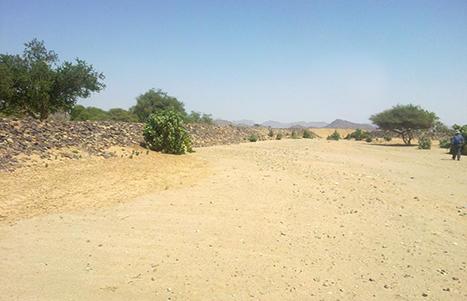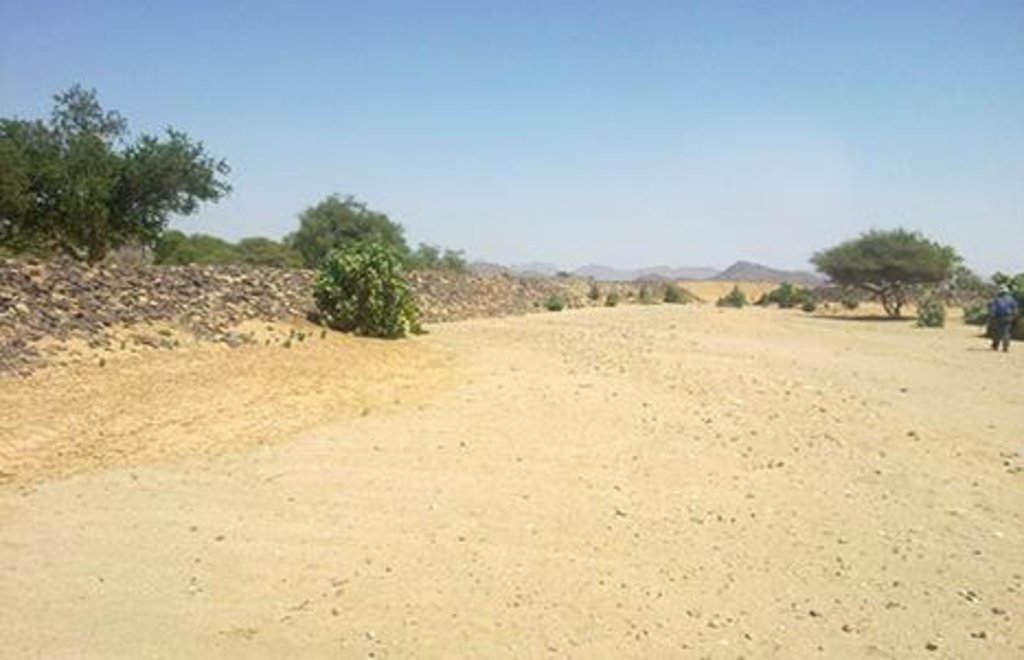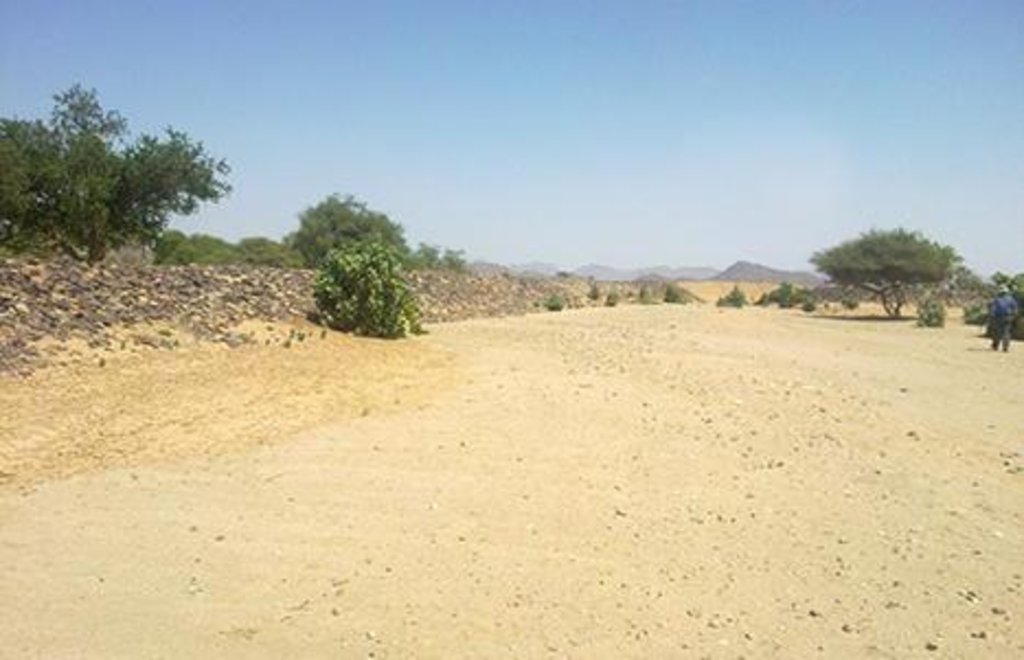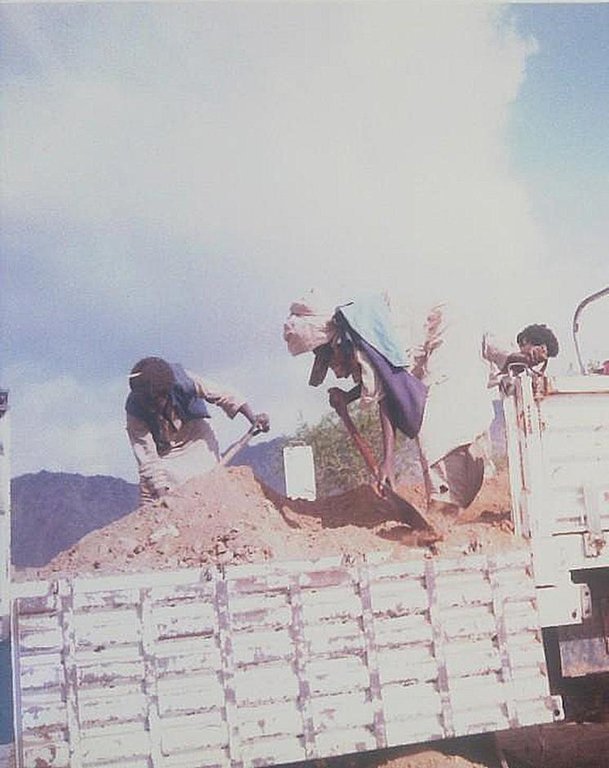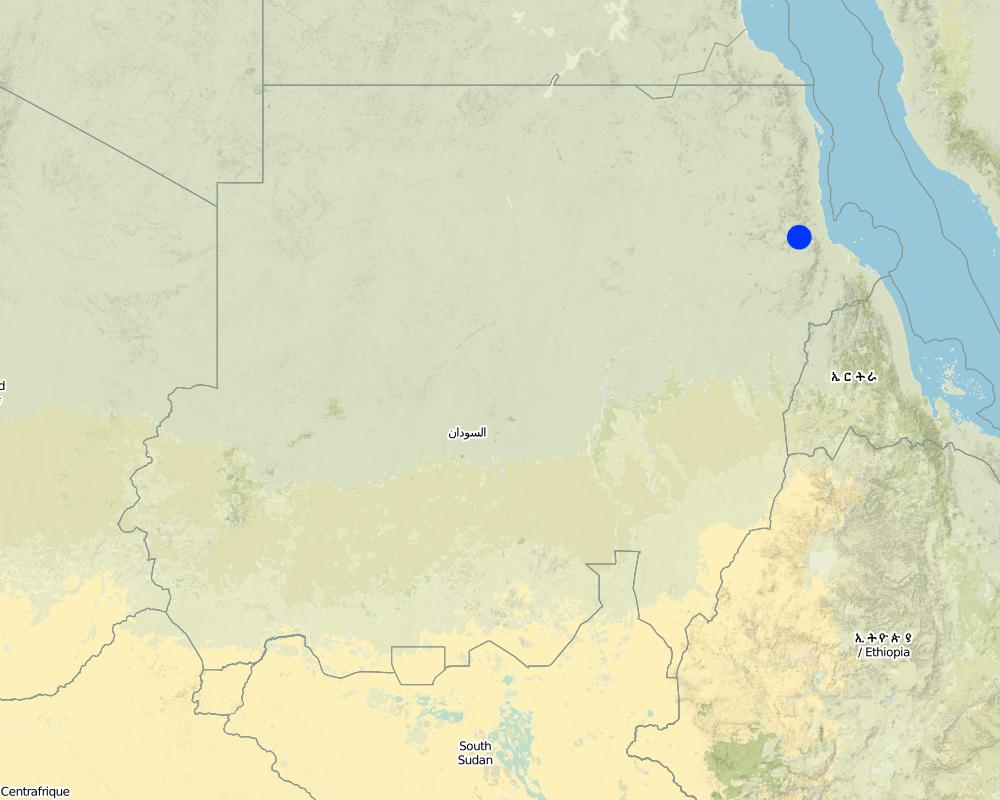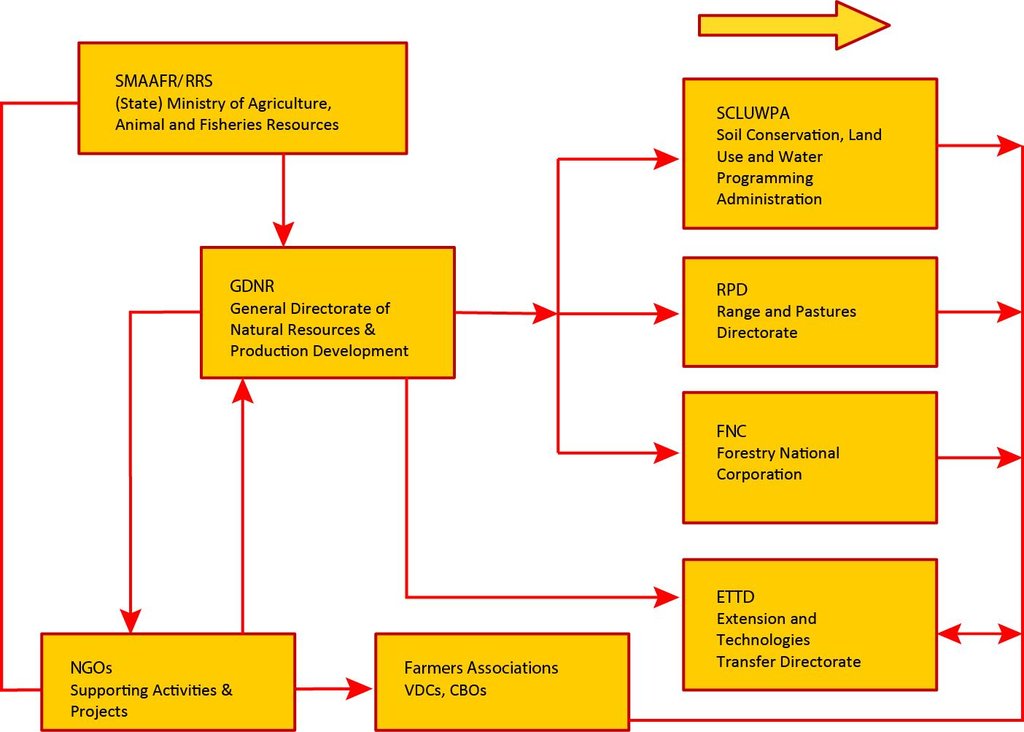Water Spreading (typical example from Hashatribab) [السودان]
- تاريخ الإنشاء:
- تحديث:
- جامع المعلومات: Abdalla Osman Eisa
- المحرر: –
- المُراجع: David Streiff
Sidud (Local Arabic) - Tarrit (Beja dialect) for earth dams
approaches_2543 - السودان
عرض الأقسام
توسيع الكل طي الكل1. معلومات عامة
1.2 تفاصيل الاتصال بالأشخاص الرئيسيين لمصدر المعلومات والمؤسسات المعنية بتقييم وتوثيق النهج
متخصص في الإدارة المستدامة للأراضي:
متخصص في الإدارة المستدامة للأراضي:
Gaiballa Abdelaziz
gaiballa@gmail.com
Sudan University of Science and Technology
السودان
متخصص في الإدارة المستدامة للأراضي:
Dabaloub Sayed
+249 912913623
dabaloub@gmail.com
SCLUWPA Dirctor (1986-1995), now the ECDP Centre
Port Sudan
السودان
اسم المؤسسة (المؤسسات) التي سهلت توثيق/تقييم النهج (إذا كان ذلك على صلة)
Soil Conservation, Land Use and Water Adminstratio (Soil Conservation, Land Use and Water Adminstratio) - السوداناسم المؤسسة (المؤسسات) التي سهلت توثيق/تقييم النهج (إذا كان ذلك على صلة)
VU University Amsterdam (VU University Amsterdam) - هولندااسم المؤسسة (المؤسسات) التي سهلت توثيق/تقييم النهج (إذا كان ذلك على صلة)
Sudan University of Science and Technology (SUST) - السودان1.3 الشروط المتعلقة باستخدام البيانات الموثقة من خلال WOCAT
متى تم تجميع البيانات (ميدانيا)؟:
15/05/2012
يوافق جامع المعلومات والشخص (لاشخاص) الرئيسي لمصدر المعلومات على الشروط المتعلقة باستخدام البيانات الموثقة من خلال WOCAT:
نعم
1.4 المراجع الخاصة باستبيان(استبيانات) تقنيات الإدارة المستدامة للأراضي
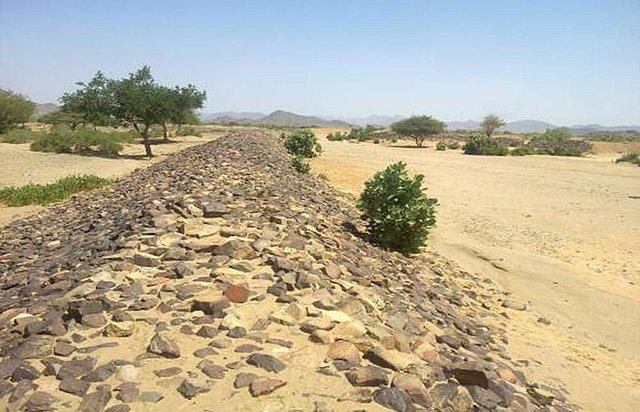
Water Spreading (typical example from Hashatribab) [السودان]
Water Spreading (or Spate Irrigation system) conducted through the construction of earth dam structures at the khor cross section.
- جامع المعلومات: Abdalla Osman Eisa
2. وصف نهج الإدارة المستدامة للأراضي
2.1 وصف موجز للنهج
Construction of water spreading system on khor and wadi with machinery jointly government and farmers in dam compaction and pitching.
2.2 وصف تفصيلي للنهج
وصف تفصيلي للنهج:
Aims / objectives: The main objective of the approach is to enable domestic land users cultivating crops (sorghum mainly) on a flood plain through construction of an earthen, stone-pitched barrier across the bed of a khor (stream). This earth dam serves to divert floodwaters onto their fields downstream. The approach is fully subsidized as the government provide technician and machines for the construction. Only some voluntary contribution from the beneficiaries is needed (for stone pitching). However maintenance support by the government is not provided later on.
This case study is typical of all those in the State. All are demand-driven...In addition the government supports farmers in rural extension e.g. preparedness, awareness, organization and mobilization, and to establish farmers VDCs (Village Development Committee) to guide the community in public works. Training and capacity building sessions in cultural extension are hold to develop crop raising techniques. The aim behind this is mainly to fill the gap of people’s deficiency in storage of crops such as sorghum and millet to maintain food security in the region.
Methods: 1/ Earth dam and terraces construction for water diversion and spreading.
2/ Agronomic measures e.g. ploughing, levelling, furrowing etc. to raise the soil to its maximum capacity.
3/ Provision of certified seeds: Varieties of short mature period and of drought resistance.
4/ Provision of special hand tools for weeding to maintain soil moistures and sustain the growing of crops.
5/ Development of mixed crop systems by provision of cash crop to support the rural economy.
Stages of implementation: 1. Identify and prioritize the needs of local beneficiaries according to their land size, social and economic situation, the local soil types, the cultivated indigenous crops etc.
2. To reach mutual partnership between Government and local communities a certain number of beneficiaries of the community is dedicated to contribute to volunteer manual work.
3. Based on peoples previous natural environment experience the location of the dam is to be examined and an engineering map has to be set out. That means people’s involvement from the very beginning of the project for planning, design and implementation.
4. For construction the government provides necessary needed machines.
5. The local community should mainly ensure the maintenance and the clearing out of the land for smooth water flow.
Role of stakeholders: Division of labor between the stockholders so as to identify the role
1- Land owners: piece of land.
2- Farmers: farming activities.
3- Ministry of Agriculture (MoA): provide machinery and technical support.
4- SLM specialist: will give the technical advice.
Other important information: Floodwater now takes way to any lower area and creates a new water course.
After several years soil should be tilled by ploughing, planking and furrowing to increase water infiltration and percolation as over the years the accumulated silt turns the soils nearly impermeable.
Finally some types of soil in the Red Sea State become very fertile and rich and do not need chemical or organic fertilizers anymore.
2.3 صور عن النهج
2.5 البلد/المنطقة/المواقع التي تم تطبيق النهج فيها
البلد:
السودان
المنطقة/الولاية/المحافظة:
Red Sea State
مزيد من التفاصيل حول الموقع:
Sinkat Locality
التعليقات:
This covers the case study of Hashtribab water spreading scheme as documented in the associated QT though is an approach used all over the State. e.g. Erkawit.
Map
×2.6 تواريخ بدء وإنهاء تنفيذ النهج
أشر إلى سنة البدء:
1970
2.7 نوع النهج
- قائم على مشروع/برنامج
2.8 الغايات/الأهداف الرئيسية للنهج
The Approach focused mainly on SLM with other activities (Rehabilitation of natural resources and agriculture for improving soil conditions and fertility. )
To overcome the inability of poor farmers to invest in durable water harvesting schemes and (later; in the 1990s and onwards) to take over the implementational role from NGOs and donors. They could continue to invest but they should be stopped to be concernde with implementation as they were in the 1970s and 1980s
The SLM Approach addressed the following problems: Lack of water to grow crops, lack of money for farmers to invest in infrastructure.
2.9 الظروف التي تمكن أو تعيق تنفيذ التقنية/التقنيات المطبقة بموجب النهج
المعايير والقيم الاجتماعية /الثقافية/ الدينية
- معيق
Lack of machinery and money to construct durable schemes
Treatment through the SLM Approach: Assistance from Government
توفر/الوصول إلى الموارد والخدمات المالية
- معيق
1/Limited resources specially in the infrastructure of the concerned government departments
2/ Low capacity of the traditionally adopted technology as well as at farmers communities level.
3/ Limited financial resources especially of extension and capacity building and training at grass root level as well as at staff level
Treatment through the SLM Approach: 1/ Raise the capacity of the technology used
2/ intensive training of both cultural, and rural extension
3/ Training in water harvesting techniques for traditional farmers and in reclamation methods in water management
4/ Encourage farmers innovations and initiatives based on community based approaches for land use management
الإطار المؤسساتي
- معيق
1/ At community level VDCs has low capacity in community organization
2/ Follow up and monitoring is very limited and at an adhoc bases where as carried on occasionally
3/ serious problem as related to water spreading and diversions usually vulnerable to breakage and washed out. The miss located sites of earth dam constriction is the main factor behind
Treatment through the SLM Approach: Raising the capacity of Gov. Dept. in extension techniques and the most develop water harvesting methods
الإطار القانوني (حيازة الأراضي، وحقوق استخدام الأراضي والمياه)
- معيق
Some conflicts on some areas arise
Treatment through the SLM Approach: Negotiation between parties / stakeholders under their traditional leadership (tribal)
المعرفة حول الإدارة المستدامة للأراضي، والوصول إلى الدعم الفني
- معيق
Lack of technical training
Treatment through the SLM Approach: Fund for training should be available
عبء العمل، توفر القوى العاملة
- معيق
partnership between different partners with less extent of homogeneity and commitment.
Treatment through the SLM Approach: strength the linkage between different partners in the targeted activities.
غير ذلك
- معيق
Wage differences between NGO staff and government employees
Treatment through the SLM Approach: Top-up payment to government employees
3. المشاركة وأدوار الأطراف المعنية
3.1 أصحاب المصلحة المعنيون بالنهج وأدوارهم
- مستخدمو الأراضي المحليون/المجتمعات المحلية
Farmers with VDCs and individuals.
The adult (40 years) and youth (20 – 30 years). Rarely it has be taken by women
It can be said that the whole community is economically disadvantaged
Men predominant in meeting and negotiations. This were conducted through the VDC's and community elected community board.
- متخصصون في الإدارة المستدامة للأراضي / مستشارون زراعيون
Extension agents
- منظمة غير حكومية
- الحكومة الوطنية (المخططون، صانعو القرار)
Soil Conservation Department (SCLUWPA) (named differently in different parts of the country), Range and Pastures and Forestry Dirctorates
Community leaders (tribal), Localities assembly, VDCs, Community representatives and Ministers at State level
3.2 انخراط مستخدمي الأراضي المحليين/المجتمعات المحلية في المراحل المختلفة للنهج
| انخراط مستخدمي الأراضي المحليين/المجتمعات المحلية | حدد من شارك وصف الأنشطة | |
|---|---|---|
| المبادرة/التحفيز | التعبئة الذاتية | Demand-driven |
| التخطيط | تفاعلي | Together with specialists |
| التنفيذ | تفاعلي | Some subsidized labour and in some cases volonteer labours |
| الرصد/التقييم | غير موجود | None |
| Research | غير موجود | Some information provided |
3.3 مخطط التدفق (إذا كان متاحًا)
الوصف:
Institutional framework: Stakeholders and their roles: cross-disciplinary linkages between SMAAFR, collaborating institutions and farmers.
المؤلف:
Abdalla Osman Eisa (Soil Conservation and Land Use Admin. Red Sea State, Sudan)
3.4 اتخاذ القرار بشأن اختيار تقنية/تقنيات الإدارة المستدامة للأراضي
حدد من الذي قرر اختيار التقنية/التقنيات التي سيتم تنفيذها:
- مستخدمو الأراضي بشكل أساسي، بدعم من متخصصي الإدارة المستدامة للأراضي
اشرح:
Most of the schemes (of which Hashatribab is a good example) began as a traditional water spreading schemes. Thus the Government built upon the traditionally adopted farmer's technology and developed it my means of improved soil and crop management knowledges and capacity bulding to farmers.
Decisions on the method of implementing the SLM Technology were made by mainly by SLM specialists with consultation of land users. The machinery necessary was in the hands of the Government and the specialists knew what was possible and how it could be done. But for all the land users were consulted.
To develop the traditionally adopted technology it is in the hand of the people themselves and need to be supported by the government. Such technology men are dealing with the natural resources, preventing tree cutting, moving regularly for grazing governance to recover ranges etc. and also they need hand tools awareness techniques.
4. الدعم الفني وبناء القدرات وإدارة المعرفة
4.1 بناء القدرات/التدريب
هل تم تقديم التدريب لمستخدمي الأراضي / الأطراف المعنيين الآخرين؟:
نعم
حدد من تم تدريبه:
- مستخدمو الأراضي
- موظفون ميدانيون/ مستشارون
- other related goverment Departments
إذا كان ذلك على صلة، حدد الجنس والعمر والوضع والعرق وما إلى ذلك.
on gender basis.
شكل التدريب:
- من مزارع إلى مزارع
- اجتماعات عامة
المواضيع المغطاة:
Rural extension as community organization, public work methods, extension and awareness services
4.2 خدمة استشارية
هل يملك مستخدمو الأراضي وصولا إلى خدمة استشارية؟:
نعم
حدد ما إذا كانت الخدمة الاستشارية متوفرة:
- في حقول مستخدمي الأراضي
وصف/تعليقات:
Conventional extension; Key elements: 1.Visits, 2.Training, 3.Practice and training by doing ; Cross visits are very important to improve the technical know how and to learn by experience. The practical training is very useful and effective rather to the theoretical one.
Advisory service is quite adequate to ensure the continuation of land conservation activities; Yes, in terms of technical know how but not in terms of adequate resources
4.3 تعزيز المؤسسات (التطوير التنظيمي)
هل تم إنشاء أو تعزيز مؤسسات من خلال هذا النهج؟:
- نعم، قليلا
حدد المستوى (المستويات) التي تم فيها تعزيز أو إنشاء المؤسسات:
- محلي
- man power
اعط مزيدا من التفاصيل:
Because the local institution was involved in negotiations with the Government and also organizing communities; mobilization and awareness. SCLUWPA activities are mainly oriented to conserve soil and vegetation. They tend to clarify land according to the amount of Khor floods into land for agriculture and the land of forests and ranges. This practice is carried on down streams of seasonal rivers while is not specifically going in plains which in need to be reclaimed to reduce sand dunes formation and desert like conditions
4.4 الرصد والتقييم
هل يشكل الرصد والتقييم جزءا من النهج؟:
نعم
التعليقات:
There were no changes in the Approach as a result of monitoring and evaluation: Not relevant as no monitoring took place. Only monitoring and evaluation is carried on by SCLUWPA for its activities in earth dams' construction and terraces to speed water. Usually this takes places after and within the period of flooding in addition to sea wall, effectively these devices functioned and finally to trace the impact and the outcome.
There were no changes in the Technology as a result of monitoring and evaluation: as above. In purpose of to check what have done to do some amendments.
4.5 البحوث
هل كانت البحوث جزءًا من النهج؟:
نعم
حدد المواضيع:
- علم الايكولوجيا
5. التمويل والدعم المادي الخارجي
5.1 الميزانية السنوية لمكون الإدارة المستدامة للأراضي في النهج المذكور
إذا لم تكن الميزانية السنوية الدقيقة معروفة، قم بالإشارة إلى نطاقها:
- 10,0000-2,000
التعليقات (على سبيل المثال المصادر الرئيسية للتمويل/الجهات المانحة الرئيسية):
Approach costs were met by the following donors: international (Training, capacity building and assistance of equipment.): 30.0%; government (Technical staff, equipment and agricultural inputs.): 60.0%; local community / land user(s) (Volunteer man power): 10.0%
5.2 الدعم المالي/المادي المقدم لمستخدمي الأراضي
هل حصل مستخدمو الأراضي على دعم مالي/ مادي لتنفيذ التقنية/ التقنيات؟:
نعم
إذا كانت الإجابة بنعم، حدد نوع (أنواع) الدعم والشروط والمزودين:
By Government either directly or from donor sources. SCLUWPA, Range and Pastures, UNDP and UNISCO supporting desertification.
5.3 إعانات لمدخلات محددة (بما في ذلك العمالة)
- معدات
| حدد المدخلات التي تم دعمها | إلى أي مدى | حدد الإعانات |
|---|---|---|
| أدوات | ممول بالكامل | |
- زراعة
| حدد المدخلات التي تم دعمها | إلى أي مدى | حدد الإعانات |
|---|---|---|
| بذور | ممول بالكامل | |
- بناء
| حدد المدخلات التي تم دعمها | إلى أي مدى | حدد الإعانات |
|---|---|---|
| حجر | ممول جزئيا | partial community contribution |
| خشب | ممول جزئيا | partial community contribution |
إذا كان العمل من قبل مستخدمي الأراضي مدخلاً جوهريًا، فهل كان:
- تطوعي
التعليقات:
see QT
Only machinery financed for construction period and maintenance.
Labour appears in all mentioned forms above. But voluntarely and food for work is most common.
5.4 الائتمان
هل تم توفير ائتمان في إطار نهج أنشطة الإدارة المستدامة للأراضي؟:
كلا
6. تحليل الأثر والتصريحات الختامية
6.1 آثار النهج
هل ساعد النهج مستخدمي الأراضي على تنفيذ وصيانة تقنيات الإدارة المستدامة للأراضي؟:
- لا
- نعم، قليلا
- نعم، باعتدال
- نعم، إلى حد كبير
They were able to make the land directly more productive because of the extra water. Furthermore it helped land users in raising their technical know how.
هل ساهم النهج في تمكين الفئات المحرومة اجتماعيا واقتصاديا؟:
- لا
- نعم، قليلا
- نعم، باعتدال
- نعم، إلى حد كبير
Yes, as the whole community was economically disadvantaged
هل أدى النهج إلى تحسن في مسائل حيازة الأراضي / حقوق المستخدمين التي أعاقت تنفيذ تقنيات الإدارة المستدامة للأراضي؟:
- لا
- نعم، قليلا
- نعم، باعتدال
- نعم، إلى حد كبير
no problems related to that issue of land rights and ownership and early can be recognized by tribal leadership. The problem is likely to be overcome in the near future. within the tribal system it can be solved any problems on land in cases of difficulties the leadership take decision to be used by all members.
Did other land users / projects adopt the Approach?
- لا
- نعم، قليلا
- نعم، باعتدال
- نعم، إلى حد كبير
Not relevant as it is a government driven system. The newly introduced technology is to improve before it can be adopted by other land users.
Did the Approach lead to improved livelihoods / human well-being?
- لا
- نعم، قليلا
- نعم، باعتدال
- نعم، إلى حد كبير
Yes, because of extra food supply – though not as dramatic as with irrigation By using simple technology e.g. the hand tools and ohter manually applicable implements can be used easily by land users.
Did the Approach help to alleviate poverty?
- لا
- نعم، قليلا
- نعم، باعتدال
- نعم، إلى حد كبير
In terms of food security: but differs from season to season If support subsistence farmers to produce crop and animal herders to multiply animal numbers.
6.2 المحفز الرئيسي لقيام مستخدمي الأراضي بتنفيذ الإدارة المستدامة للأراضي
- زيادة الإنتاج
The primary motivation
- well-being and livelihoods improvement
Also very important
6.3 استدامة أنشطة النهج
هل يمكن لمستخدمي الأراضي المحافظة على استدامة ما تم تنفيذه من خلال النهج (بدون دعم خارجي)؟:
- لا
إذا كان الجواب لا أو غير متأكد، حدد ذلك وعلق عليه:
The land users can continue to crop and to maintain structures within their ability, but no expansion would be possible or repairs to major breakages, unless the level of surplus production will be reached.
6.4 نقاط قوة/مزايا النهج
| نقاط القوة/ المزايا/ الفرص من وجهة نظر مستخدمي الأراضي |
|---|
|
1) Improve the socioeconomic situation. 2) Learning and improve their technical capacity. 3) Raising the community awareness and preparedness. 4) Encourage peoples to be involved in collective action. 5) Enhance their capacity of community effective. Management resources (How to sustain/ enhance this strength: -Building and strengthening the establishment of the community institutions i.e. from VDCs to local Community Base Organization CBos national NGos.) |
| نقاط القوة/ المزايا/ الفرص من وجهة نظر جامع المعلومات أو غيره من الاشخاص الرئيسيين لمصدر المعلومات |
|---|
|
1/ Demand driven response to people’s needs. 2/ Reducing the direct in-field role of NGOs. 3/ Progress to create a national Ngo's. 4/ Building the community institution. 5/ Raising the self help and self reliance for sustainable management. (How to sustain/ enhance this strength: 1/ Continue to listen to the people 2/ By making sure the Government continues to play that role effectively 3/Increase funding . ) |
6.5 نقاط الضعف/ العيوب في المنهج وطرق التغلب عليها
| نقاط الضعف/ المساوىء/ المخاطر من وجهة نظر مستخدم الأراضي | كيف يمكن التغلب عليها؟ |
|---|---|
|
1) Weak economic base at rural areas. 2) Weak community innovation and involvement. 3) Illiteracy and isolated and knowledge of others experiences 4) Low level of the technology used by the people. 5) Poverty and high vulnerability to natural disasters. |
- to increase land productivity. - to develop crop mixing strategy to include cash crops. - enhance and encourage agroforestry approach. |
| نقاط الضعف/ المساوىء/ المخاطر من وجهة نظر جامع المعلومات أو غيره من الاشخاص الرئيسيين لمصدر المعلومات | كيف يمكن التغلب عليها؟ |
|---|---|
|
1/ Weak of funds. 2/ Weak of monitoring and evaluation. 3/ Low of documentation and knowledge sharing. 4) Lack of research involvement. It is better to say few or adequate research activity |
1/ More support. 2/ Introduce a clear, simple system. 3/ International community need to make more efforts to assist with these aspects. 4/ Both Government and NGOs need to recognise the potential role of researchers |
7. المراجع والروابط
7.1 طرق جمع/مصادر المعلومات
- زيارات ميدانية، مسوحات ميدانية
الروابط والوحدات المواضيعية
توسيع الكل طي الكلالروابط

Water Spreading (typical example from Hashatribab) [السودان]
Water Spreading (or Spate Irrigation system) conducted through the construction of earth dam structures at the khor cross section.
- جامع المعلومات: Abdalla Osman Eisa
الوحدات المواضيعية
لا يوجد وحدات مواضيعية


